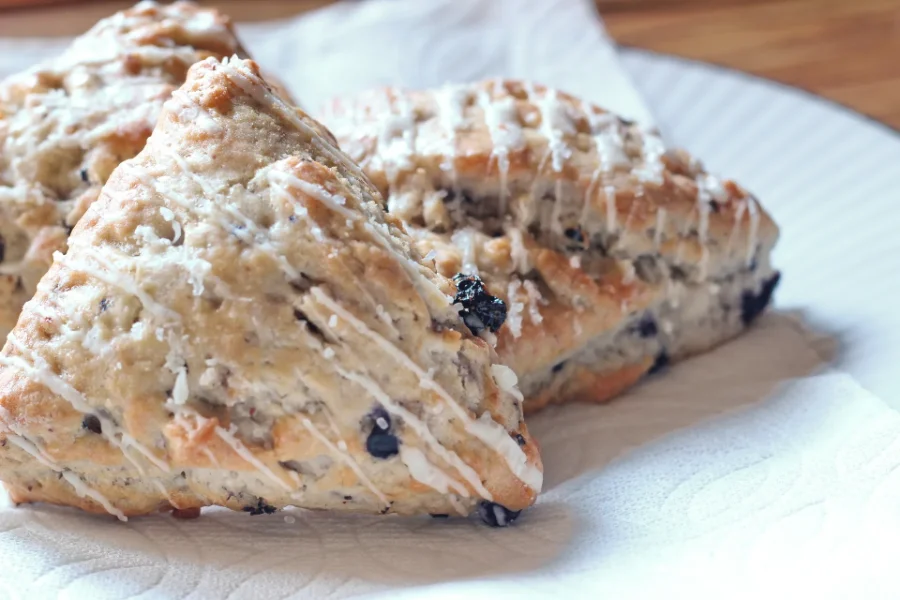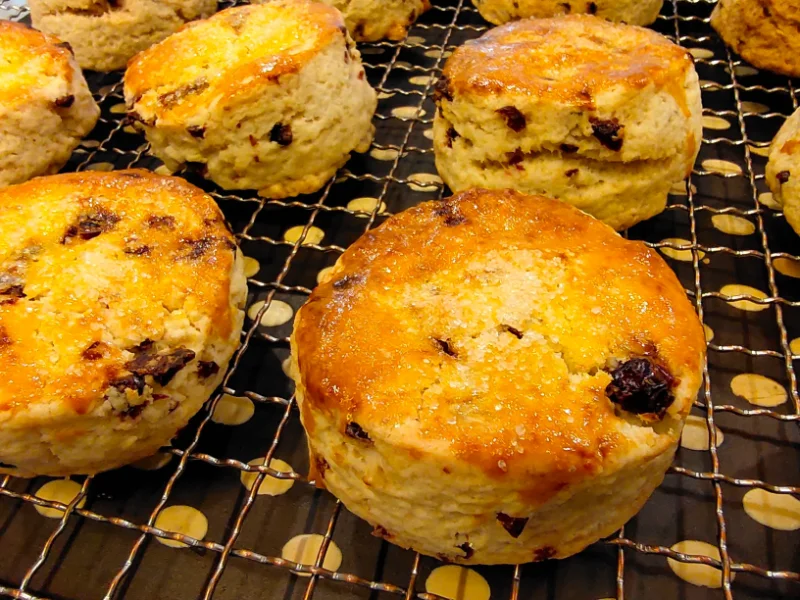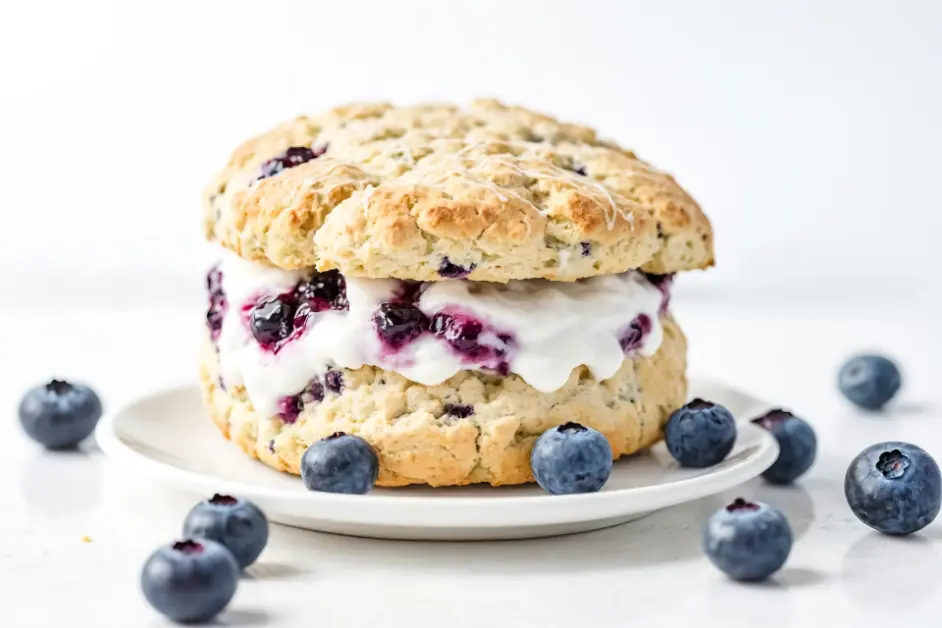Introduction
Classic fruit scones have been a tea-time favorite for centuries. They originated in Scotland, where people made them from oats and cooked them on griddles. Over time, the recipe changed, and scones became the fluffy, baked treats we know today. The tradition of serving scones with tea became popular in the 1840s when Anna, the Duchess of Bedford, introduced afternoon tea. Since then, scones have become a staple in British culture, often served warm with clotted cream and jam.
Fruit scones are a classic choice because they offer the perfect balance of sweet taste and special texture. The addition of dried fruits like currants, raisins, or sultanas gives them a chewy bite and a natural burst of flavor. They are easy to make and pair well with tea or coffee, making them ideal for breakfast, brunch, or a relaxing afternoon snack. Their simple ingredients and quick preparation make them a go-to recipe for both beginner and experienced bakers.
The perfect scone should be light, fluffy, and slightly crumbly. Cold butter, self-raising flour, and gentle mixing are key to achieving the right texture. Overmixing the dough can make scones tough, while too much flour can dry them out. A well-made scone rises tall, has a golden crust, and a soft, buttery center. The sweetness should be subtle, allowing the flavors to shine without overpowering the traditional toppings.
In this guide, you will learn how to make the best classic fruit scones from scratch. We will cover the best ingredients, expert techniques, and common mistakes to avoid. You will also discover how to serve them for an authentic British afternoon tea experience. Whether you are new to baking or a pro with high experience, this step-by-step guide will provide you with necessary help to achieve perfect scones every time.
What Are British Fruit Scones?
The Difference Between British and American Scones
British scones and American scones may look similar, but they are very different. British scones are light, fluffy, and less sweet. They have a soft, crumbly texture and rise tall when baked. American scones, on the other hand, are denser, sweeter, and often packed with mix-ins like chocolate chips or nuts.
Serving styles also differ. In Britain, scones are served warm with clotted cream and jam. They are part of a traditional afternoon tea. In the U.S., scones are usually eaten plain or with a glaze. They are often enjoyed as a grab-and-go breakfast item rather than a tea-time treat.
The Traditional Ingredients Used in British Scones
Classic British scones use simple pantry staples. Self-raising flour gives them a perfect rise. Butter adds richness and a flaky texture. Sugar provides a slight sweetness without overpowering the flavor. Milk and eggs create a soft and tender crumb. Dried fruit, such as currants or raisins, adds natural sweetness and texture. These ingredients combine harmoniously to produce a delicious and well-textured scone.
Why Fruit Scones Are a Tea-Time Favorite
Fruit scones are an essential part of British afternoon tea.They are traditionally enjoyed with jam and clotted cream, making them a delightful sweet treat. Their light texture pairs perfectly with a cup of tea. Many people love them because they are not overly sweet. This makes them a great option for both breakfast and an afternoon snack. Their simple recipe and quick preparation make them a favorite among home bakers.
The Best Fruits to Use in Scones
The best fruit for scones adds natural sweetness without making them too heavy. Currants are the most traditional choice. They are small, slightly tart, and mix well into the dough. Raisins are another popular option, offering a chewy bite and mild sweetness. Sultanas are similar to raisins but slightly juicier and sweeter. Some bakers also use chopped dates for a richer flavor. No matter which fruit you choose, it should be evenly distributed for the best taste in every bite.
Ingredients and Tools You Need to Make Classic Fruit Scones

Essential Ingredients for Traditional Fruit Scones
To make classic fruit scones, you need a few simple ingredients. Flour gives the scones structure, while butter adds a rich, flaky texture. Sugar provides a slight sweetness, balancing the flavors. Baking powder allows the scones to rise, giving them a light and airy texture. Eggs add moisture and richness, while milk brings the dough together. Dried fruit, like currants or raisins, gives scones a chewy texture and natural sweetness. Each ingredient plays a its part in creating the perfect scone.
Choosing the Best Flour for Perfect Scones
Self-raising flour is the best choice for scones. It contains a perfect mix of flour and leavening agents, helping the dough rise evenly. This type of flour makes scones lighter and fluffier than plain flour. If you don’t have self-raising flour, you can make your own by adding baking powder to plain flour. Using the right flour ensures the best texture and taste.
Must-Have Kitchen Tools for Baking Scones
Using the proper tools simplifies baking and enhances the experience. A mixing bowl is crucial for blending ingredients efficiently. A pastry cutter helps blend butter into the flour without melting it. A rolling pin flattens the dough to the perfect thickness. A biscuit cutter creates evenly shaped scones that bake evenly. A baking sheet holds the scones while they bake to a golden brown. These tools help you achieve the best results with minimal effort.
Optional Additions for Extra Flavor
You can enhance your scones with a few extra ingredients. Vanilla extract adds a warm, sweet aroma. Lemon zest brings a hint of citrus freshness. Cinnamon or nutmeg adds a subtle spice, making the scones more flavorful. These little enhancements can greatly impact the flavor. Try out different combinations to discover your ideal taste.
Step-by-Step Guide to Making Classic Fruit Scones
Preparing the Dough Correctly
mix dry ingredients in a large mixing bowl. Add self-raising flour, sugar, baking powder, and a small pinch of salt to enhance the flavor. Cut the cold butter into small cubes, then use a pastry cutter or your fingertips to blend it into the dry mixture. Continue mixing until the texture resembles coarse breadcrumbs, ensuring the butter is evenly distributed.
Next, gently fold in the dried fruit of your choice, such as currants, raisins, or sultanas, to spread them evenly throughout the dough. Slowly pour in the milk, stirring lightly until the mixture just starts to come together. Be careful not to overmix, as this can lead to dense, heavy scones. The dough should be soft but still slightly firm, making it easy to shape and cut.
The Secret to Light and Fluffy Scones
Cold butter is the key to a perfect scone. It creates pockets of air that make the texture light and flaky. Always use chilled butter and handle it as little as possible. Gentle kneading is also important. Overworking the dough makes the scones tough. Lightly knead it just a few times until smooth. A soft and airy dough will give you tall, fluffy scones with a tender crumb.
Shaping and Cutting the Scones for the Best Rise
Flatten the dough to approximately ¾ inch in thickness. For evenly shaped scones, use a round biscuit cutter. Press it straight down without twisting to help the scones rise properly. If you don’t have a cutter, shape the dough by hand and cut it into wedges. Both methods work well, but a cutter gives a more uniform look.
Baking Temperature and Timing for Perfect Scones
Preheat the oven to 425°F (220°C). A high oven temperature allows the scones to rise fast and form a golden crust. Place the scones on a lined baking sheet, spacing them slightly apart. Bake for 12-15 minutes until they are golden and well-risen. The high heat ensures a crisp outside and a soft, fluffy inside.
How to Tell When Your Scones Are Ready
Check for a golden brown top and a slightly firm texture. Tap the bottom of a scone—if it sounds hollow, they are done. Let them cool slightly before serving. Freshly baked scones taste best when warm with clotted cream and jam. Enjoy them with a cup of tea for the perfect British experience.
How to Serve and Enjoy Your Fruit Scones

The Best Way to Serve British Scones
The traditional way to enjoy British scones is with clotted cream and jam. Slice the scone in half while it is still warm. Spread a generous layer of fruity jam, such as strawberry or raspberry. Then, add a thick dollop of clotted cream on top. Some people prefer to put the cream first, then the jam. Either way, the combination creates a rich, delicious treat. Serve them on a plate with a cup of tea for an authentic British experience.
Choosing the Perfect Tea to Pair with Scones
Tea and scones go hand in hand. English Breakfast tea is a classic choice with its strong, bold flavor. Earl Grey, with its hint of citrus, adds a refreshing touch. Darjeeling offers a lighter, floral taste that balances the richness of scones. Assam tea provides a deep, malty flavor that complements the buttery texture. No matter which tea you choose, serve it hot with a splash of milk for the best pairing.
Storing and Reheating Scones
Freshly baked scones are always the most delicious, but you can store them for later while keeping their texture and flavor intact. To maintain their freshness, place them in an airtight container and keep them at room temperature for up to two days. If you need to reheat them, use a preheated oven at 350°F (175°C) and warm them for about five minutes. This method helps restore their light, flaky texture without drying them out.
Avoid reheating scones in the microwave, as it tends to make them rubbery or overly chewy. If you have leftover scones, a quick warm-up in the oven will bring back their soft, buttery interior and slightly crisp exterior. For the best results, enjoy them fresh or reheat gently before serving with your favorite toppings.
Can You Freeze Scones?
Yes, scones freeze well. Let them cool completely before storing them in a sealed freezer bag. For the best results, freeze them on a tray first, then transfer them to a bag. When ready to eat, reheat them in the oven at 350°F (175°C) for about 10 minutes. This keeps them fresh and delicious. Freezing scones is a great way to enjoy homemade treats anytime.
Common Mistakes and Expert Tips for Perfect Scones

Why Do Scones Turn Out Dry or Dense?
Dry or dense scones often come from common mistakes. Overmixing the dough makes scones tough and heavy. Too much flour absorbs moisture, leaving it dry. Not using enough butter reduces richness and flakiness. To fix this, mix the dough gently and stop as soon as it comes together. Use the right amount of flour, and always measure ingredients correctly. Adding cold butter in small cubes helps create a light and flaky texture.
How to Prevent Scones from Spreading Too Much
Keeping ingredients cold is the secret to well-shaped scones. Warm butter melts too soon, causing the dough to spread. Always use chilled butter and milk Minimize handling the dough to avoid warming it with your hands. After shaping the scones, chill them for 10 minutes before baking. A hot oven also helps them rise quickly instead of spreading out.
Can You Make Scones Without Butter or Eggs?
Yes, you can make vegan and dairy-free scones with simple swaps. Substitute butter with coconut oil or a dairy-free margarine alternative. Use plant-based milk, such as almond or oat milk, instead of regular milk. To replace eggs, mix one tablespoon of ground flaxseeds with three tablespoons of water. This keeps the dough soft and helps it hold together. Vegan scones may have a slightly different texture, but they can still be light and delicious.
Tips for Making Scones Ahead of Time
You can prepare scone dough in advance to save time. After mixing the dough, shape it and cut out the scones. Arrange them on a baking sheet, cover them, and store in the refrigerator for up to 24 hours.. When ready to bake, preheat the oven and bake them straight from the fridge. If you want to freeze the dough, do it before baking. Frozen scone dough can go directly into the oven, adding a couple of extra minutes to the baking time. This method ensures fresh, warm scones anytime.
Classic Fruit Scones Recipe: Ingredients and Instructions

Classic Fruit Scones Recipe
Ingredients
Method
- Preheat the Oven – Set your oven to 220°C (425°F) and line a baking tray with parchment paper.
- Mix Dry Ingredients – In a large bowl, combine flour, baking powder, sugar, and salt.
- Add Butter – Rub the cold butter into the dry ingredients using your fingertips until it looks like breadcrumbs.
- Add Fruit – Stir in the dried fruit evenly.
- Mix Wet Ingredients – In a separate bowl, whisk the egg and milk together.
- Form the Dough – Gradually pour the wet mixture into the dry ingredients, mixing gently until a soft dough forms. Do not overmix.
- Shape and Cut – Lightly flour a surface, roll out the dough to about 2 cm (¾ inch) thick, and cut out rounds using a cutter or shape by hand.
- Glaze – Brush the tops with egg yolk for a golden finish.
- Bake – Place on the baking tray and bake for 12–15 minutes until risen and golden brown.
- Serve – Let them cool slightly, then serve warm with clotted cream and jam.
FAQs: Classic Fruit Scones Recipe
1. Can I substitute plain flour for self-raising flour?
Yes, you can use plain flour, but you need to add baking powder. For every cup (120g) of plain flour, add 2 teaspoons of baking powder. This helps the scones rise properly.
2. What is the best fruit to use in scones?
Currants, raisins, and sultanas are the most popular choices. You can also use chopped dates, dried cranberries, or apricots for a different flavor.
3. How do I make my scones rise higher?
Use cold butter, avoid overmixing the dough, and press the cutter straight down without twisting. Chilling the shaped scones for 10 minutes before baking also helps them rise.
4. Why are my scones dry and crumbly?
Too much flour or overmixing can make scones dry. Use the correct measurements and mix gently. Also, make sure to use enough butter and milk to keep the dough moist.
5. Can I make fruit scones without eggs?
Yes, you can leave out the egg and add a little extra milk. You can also use a flaxseed egg (1 tablespoon flaxseed + 3 tablespoons water) as a substitute.
Conclusion
Making the perfect British fruit scones is easy when you follow the right steps. Use cold butter, self-raising flour, and gentle mixing to get a light and fluffy texture. Avoid overworking the dough, and always bake at the right temperature. These small details make a big difference in achieving soft, golden scones.
Feel free to experiment with different fruits. Currants, raisins, and sultanas are classic choices, but you can also try cranberries, apricots, or chopped dates. Adding citrus zest or spices like cinnamon can give your scones a unique twist. Trying new flavors makes baking even more fun.
If you give this classic fruit scone recipe a try, we’d love to hear about your experience! Share your results in the comments and let others know what techniques or ingredients worked best for you. Did you experiment with different fruits or flavors? Your insights could help fellow bakers improve their own scones.
If you have any questions or need troubleshooting tips, don’t hesitate to ask. Baking is a journey, and learning from each other makes it even more enjoyable. Whether you’re a beginner or an experienced baker, every attempt brings new discoveries. Let’s create the perfect scones together!
Pair your scones with other delicious tea-time treats. Serve them with biscuits, shortbread, or a slice of Victoria sponge cake. A hot cup of English Breakfast or Earl Grey tea makes the perfect match. Enjoy your homemade scones with family and friends, and create your own afternoon tea tradition.
for more recipes, try our:


4 thoughts on “Classic Fruit Scones Recipe: How to Make Perfect British Scones”